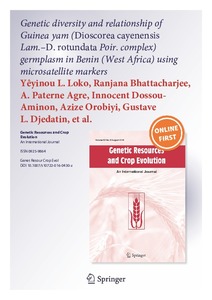| dc.contributor.author | Loko, Y.L. |
| dc.contributor.author | Bhattacharjee, R. |
| dc.contributor.author | Agre, A.A. |
| dc.contributor.author | Dossou-Aminon, I. |
| dc.contributor.author | Orobiyi, A. |
| dc.contributor.author | Djedatin, G.L. |
| dc.contributor.author | Dansi, M. |
| dc.date.accessioned | 2019-12-04T11:03:52Z |
| dc.date.available | 2019-12-04T11:03:52Z |
| dc.date.issued | 2016-08-23 |
| dc.identifier.citation | Loko, Y. L., Bhattacharjee, R., Agre, A.P., Dossou-Aminon, I., Orobiyi, A., Djedatin, G.L. & Dansi, A. 2016. Genetic diversity and relationship of Guinea yam (Dioscorea cayenensis Lam.–D. rotundata Poir. complex) germplasm in Benin (west Africa) using microsatellite markers. Genetic Resources and Crop Evolution, 1-15. |
| dc.identifier.issn | 0925-9864 |
| dc.identifier.uri | https://hdl.handle.net/20.500.12478/1263 |
| dc.description.abstract | Guinea yam (Dioscorea cayenensis–D. rotundata complex) is an important tuber crop that highly contributes to food security and poverty alleviation in Benin. The knowledge and understanding of the extent of genetic variation of Guinea yam germplasm is important for planning of the genetic conservation, and the utilisation of this resource. The objective of this study was to assess the genetic diversity and relationships of 64 yam landraces whose dried chips are considered as resistant to insect attacks using 41 simple sequence repeat. Among these primers, 13 were found to be polymorphic, giving 113 polymorphic alleles. The number of alleles per locus ranged from 4 (Ym50) to 13 (Ym29), with an average of 8.69. Unique allele was observed with some landraces (Singou and Tchakatchaka) and can be considered as unique gene and use in yam breeding program. The mean polymorphic information content values for all markers used was 0.76 and ranged between 0.58 and 0.91 in loci YM3 and YM32 respectively. The genetic distance of yam landraces ranged from 0.45 (Yasoubagarou) to 0.04 (Assinapeira and Alahina), indicating that the yam germplasm has a high degree of genetic diversity supported by an averagely observed heterozygosity of 0.78. Cluster analysis using unweighted pair group method with arithmetic average grouped the 64 yam landraces into two distinct clusters. This tendency was also observed in the principal coordinate analysis. The analysis of molecular variance revealed that 96 % of the variation was found within the population and only 4 % between the populations. Genetic diversity and relationship assessments among the 64 yam landraces of Benin could provide useful information for efficient use of these materials, especially for genetic improvement. |
| dc.format.extent | 1-15 |
| dc.language.iso | en |
| dc.subject | Dioscorea Cayenensis |
| dc.subject | Genetic Variation |
| dc.subject | Dna |
| dc.title | Genetic diversity and relationship of Guinea yam (Dioscorea cayenensis Lam.-D. rotundata Poir. complex) germplasm in Benin (west Africa) using microsatellite markers |
| dc.type | Journal Article |
| dc.description.version | Peer Review |
| cg.contributor.crp | Roots, Tubers and Bananas |
| cg.contributor.affiliation | Polytechnic University of Abomey |
| cg.contributor.affiliation | International Institute of Tropical Agriculture |
| cg.coverage.region | Africa |
| cg.coverage.region | West Africa |
| cg.coverage.country | Benin |
| cg.isijournal | ISI Journal |
| cg.authorship.types | CGIAR and developing country institute |
| cg.iitasubject | Genetic Improvement |
| cg.iitasubject | Yam |
| cg.journal | Genetic Resources and Crop Evolution |
| cg.howpublished | Formally Published |
| cg.accessibilitystatus | Limited Access |
| local.dspaceid | 78666 |
| cg.targetaudience | Scientists |
| cg.identifier.doi | https://dx.doi.org/10.1007/s10722-016-0430-z |

